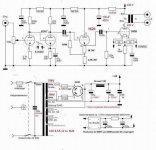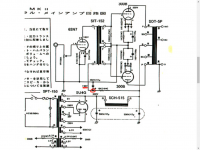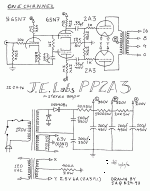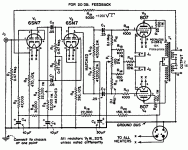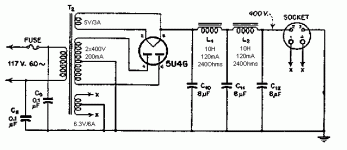In an amplifier driving a speaker, I think 'tight bass' equals high-ish damping factor. 'Loose bass,' 'woolly bass,' or 'rich, blooming bass' are most likely due to low damping factor, with subsequent looser control over the woofer causing rounded off transient response and increased output in the low frequencies.
I would say that loose, woolly or rich happens when speaker and amplifier are mismatched. The problem is not the damping factor itself. The best bass I have ever experienced is that of a current amplifier that has got zero damping factor.
The tale about the control on the woofer is just a tale. The amplifier has no control (in an active way) on anything. It's just that having low Zout the counter-current in the speaker coil will be greater BUT this is a consequence of Len's low and so it's a consequence of how speakers work. The problem is this counter-force is proportional to membrane velocity whereas the force of elastic spring due to suspensions is proportional to the displacement from the rest point. The contemporary presence of these two different forces gives non-linearity and therefore distortion!
In practice current amplifiers are very difficult to make right and most of the time constant power amps are the best compromise...with the right speakers....
Not all speakers are good enough despite their technical datasheets which are always referred to the most common type of source.
Hi 45, you say:
"The best bass I have ever experienced is that of a current amplifier that has got zero damping factor." Do you actually mean 1 damping factor not zero, that is when the output impedance of amp equal to speaker impedance, right? That is at critical damping, it is enough for tight bass. Greater than critical damping is having no advantages in small room because ... read.. what if you have bigger room?
"The best bass I have ever experienced is that of a current amplifier that has got zero damping factor." Do you actually mean 1 damping factor not zero, that is when the output impedance of amp equal to speaker impedance, right? That is at critical damping, it is enough for tight bass. Greater than critical damping is having no advantages in small room because ... read.. what if you have bigger room?
Hi 45, you say:
"The best bass I have ever experienced is that of a current amplifier that has got zero damping factor."
I mean one amplifier with very high Zout (1 Megaohm). So the damping factor is nearly zero.
I mean one amplifier with very high Zout (1 Megaohm). So the damping factor is nearly zero.
I see, is it driving a high impedance speaker maybe like electrostatic speaker directly without transformer..how to drive a normal speaker, if you step it down you get high current back.
How much plate voltage were you running on the 845? Single ended? Plate current in the primary? DC resistance of the primary? Hopefully, the OPT would be able to dissipate the heat caused by the IR drop in the primary... Quality control problems and 1 kV of plate voltage on the 845's is another problem...nothing like primary to core breakdown...Reminds me of modulation transformers in older AM transmitters...put the transformer up on 2 x 4's to keep running with the transformer case floating at HT....
Audio output transformer..DO NOT lift core ground for an audio output transformer since you don't want the speaker lines or the transformer case floating at HT....
btw the old Gates Radio BC-5E 5 kw am transmitters used 845's as audio drivers...FWIW
Audio output transformer..DO NOT lift core ground for an audio output transformer since you don't want the speaker lines or the transformer case floating at HT....
btw the old Gates Radio BC-5E 5 kw am transmitters used 845's as audio drivers...FWIW
This one fits my requirement. I have to save more money and buy this.
Thank you so much Mr. Koonw
Now I will save money to buy Dali Zenser 3 and 300Bx2 push pull (6SN7x3 5Z4 x1).
Mr. Koonw, Do you have schematic of this push pull amp that you recommend?
https://world.taobao.com/item/7709885332.htm?spm=a312a.7700714.0.0.nyRWpH#detail
Now I will save money to buy Dali Zenser 3 and 300Bx2 push pull (6SN7x3 5Z4 x1).
Mr. Koonw, Do you have schematic of this push pull amp that you recommend?
https://world.taobao.com/item/7709885332.htm?spm=a312a.7700714.0.0.nyRWpH#detail
Thank you so much Mr. Koonw
Now I will save money to buy Dali Zenser 3 and 300Bx2 push pull (6SN7x3 5Z4 x1).
Mr. Koonw, Do you have schematic of this push pull amp that you recommend?
https://world.taobao.com/item/7709885332.htm?spm=a312a.7700714.0.0.nyRWpH#detail
No find, judging from the manufacturer message : Circuit stability, welcome to come for audition compare. They welcome for audition, the location is Shenzhen. They're for export, maybe you can find a dealer in Asean countries.
Last edited:
Just found 6SN7 300B schematic from this website but in Thai. I hope it benefit someone.
http://www.thaigramophone.com/boarddetail.asp?qid=11370
Mr. KoonW is very competent in LTspice. He might knew the result of this amp in term of frequency response. So some parts of this amp might be replace for better sonic.
http://www.thaigramophone.com/boarddetail.asp?qid=11370
Mr. KoonW is very competent in LTspice. He might knew the result of this amp in term of frequency response. So some parts of this amp might be replace for better sonic.
Attachments
Frequency response of that amp will depend on the quality of the output transformer. That is not easy to model accurately in LTspice. Since this amp is single-ended, it will need a very, very good OPT, which will cost $$. A push-pull amp would have better frequency response and give more power from a smaller, cheaper output transformer, but it will be push-pull. Some people don't like that.
That last schematic is basically the classic 3-stage 6SN7 > 6SN7 > 300B single-ended design, with a 1626 cathode follower between the 2nd 6SN7 plate and 300B grid. It still would only make about 7 or 8 watts output. It's a good idea, but I'm sure somebody here will state (correctly) that it would be better to DC-couple the 6SN7 plate to the 300B grid, so you can get some A2 (grid current) operation of the 300B for a few more usable watts of output power.
Probably the better way to do this would be to use a MOSFET source follower instead of the 1626 cathode follower. This could be DC-coupled from the second 6SN7 plate, with the MOSFET source RC-coupled to the 300B grid.
These are all simple circuits, so since you're interested in this kind of thing, I'd say there is no 'best,' just different variations on a theme. I'd say go listen to some single-ended amplifiers if you can, and decide if that's the flavor you really like. Then listen to a good push-pull 2A3 or 300B amp, and see if you like that. If you decide you just have to have a single-ended amp, then go for that. If you decide you like the higher power and lower distortion of a competently designed push-pull amp, then go for that.
If you try to get 'the very best' then you'll very likely be wandering in the wilderness for a long time, buying amp after amp. The first thing to do is decide what you like. I can say that I've been living with a push-pull 2A3 amp that gives about 6W per channel, and I keep coming back to it. It just sounds good. I'm not saying you will like it. I'm just suggesting that you find what you like, and pursue that.
--
That last schematic is basically the classic 3-stage 6SN7 > 6SN7 > 300B single-ended design, with a 1626 cathode follower between the 2nd 6SN7 plate and 300B grid. It still would only make about 7 or 8 watts output. It's a good idea, but I'm sure somebody here will state (correctly) that it would be better to DC-couple the 6SN7 plate to the 300B grid, so you can get some A2 (grid current) operation of the 300B for a few more usable watts of output power.
Probably the better way to do this would be to use a MOSFET source follower instead of the 1626 cathode follower. This could be DC-coupled from the second 6SN7 plate, with the MOSFET source RC-coupled to the 300B grid.
These are all simple circuits, so since you're interested in this kind of thing, I'd say there is no 'best,' just different variations on a theme. I'd say go listen to some single-ended amplifiers if you can, and decide if that's the flavor you really like. Then listen to a good push-pull 2A3 or 300B amp, and see if you like that. If you decide you just have to have a single-ended amp, then go for that. If you decide you like the higher power and lower distortion of a competently designed push-pull amp, then go for that.
If you try to get 'the very best' then you'll very likely be wandering in the wilderness for a long time, buying amp after amp. The first thing to do is decide what you like. I can say that I've been living with a push-pull 2A3 amp that gives about 6W per channel, and I keep coming back to it. It just sounds good. I'm not saying you will like it. I'm just suggesting that you find what you like, and pursue that.
--
OH!!! WOW!! Thank you so much Mr. Rongon.
I like this phase "higher power and lower distortion" of 6SN7 300B in push pull mode.
It seems push pull will sound better when drive to "General commercial speakers".
I have to acquire more information about 300B Push Pull.
It is very interesting. If you insist me to try listen to both type (Single end 8W VS Push pull (XX watts)).
I like this phase "higher power and lower distortion" of 6SN7 300B in push pull mode.
It seems push pull will sound better when drive to "General commercial speakers".
I have to acquire more information about 300B Push Pull.
It is very interesting. If you insist me to try listen to both type (Single end 8W VS Push pull (XX watts)).
A push-pull amp would have better frequency response and give more power from a smaller, cheaper output transformer, but it will be push-pull. Some people don't like that.
that.
--
These sentence lighten me to consider 6SN7 300B in "Push Pull" mode.
Oh tube amp world is very difficult.
I have to find shop near my home to test the different between "single end" and "push pull".
Mr. Rongon seems like sound of Push Pull from what I catch the sentences.
I might misunderstood that single end sound better than push pull.
Thank you very very much.
This Sun audio of Japan might more suitable for me. It produce 25 Watts.
It can drive both my old B&W 603 S3 and of course "Dali Zensor 3".
I have to try to understand how to build this amp. I don't know what are choke & transformer of
SCH-515 ( I think it is 10H choke)
ST-152 ( I don't know this transformer) Anyone can help?
SOT-5P ( I think it is output transformer) Anyone can help?
It can drive both my old B&W 603 S3 and of course "Dali Zensor 3".
I have to try to understand how to build this amp. I don't know what are choke & transformer of
SCH-515 ( I think it is 10H choke)
ST-152 ( I don't know this transformer) Anyone can help?
SOT-5P ( I think it is output transformer) Anyone can help?
I just don't understand the value of 2 transformers in 300B push pull.
Can anyone explain please?
1. SIT-152 (what is this 8-Pin transformer???) What value I need?
2. SOT-5P (output transformer)
Just found other link of 2A3
http://www.diyaudio.com/forums/tubes-valves/194645-chinese-amp-2a3-6sn7-6sj7-5z5p-push-pull.html
Can anyone explain please?
1. SIT-152 (what is this 8-Pin transformer???) What value I need?
2. SOT-5P (output transformer)
Just found other link of 2A3
http://www.diyaudio.com/forums/tubes-valves/194645-chinese-amp-2a3-6sn7-6sj7-5z5p-push-pull.html
Attachments
Last edited:
Another schematic 6SN7 2A3
It is also interesting 🙂
and finally for Buy it Yourself (BIY) like me.
2A3 PP Push-Pull Tube Amplifier PCB (Stereo)_Bare PCB_Analog Metric - DIY Audio Kit
This one might be easy to reduce my time.
Or the easy old one from audioroot website 807 Push Pull 30 W
Amplifiers | audioroot
More homework to do 😀
It is also interesting 🙂
and finally for Buy it Yourself (BIY) like me.
2A3 PP Push-Pull Tube Amplifier PCB (Stereo)_Bare PCB_Analog Metric - DIY Audio Kit
This one might be easy to reduce my time.
Or the easy old one from audioroot website 807 Push Pull 30 W
Amplifiers | audioroot
More homework to do 😀
Attachments
Last edited:
SIT-152 is an interstage transformer used for phase splitting. It will probably be a very expensive part.
Here are some good websites for learning about how tube amps work.
How to design valve guitar amplifiers
What Do the Terms "Push-Pull" and "Single-Ended" Mean?
If you're really interested in DIY, you will want to get a good book that explains how all this stuff works. I like "Valve Amplifiers" by Morgan Jones, and "Designing High Fidelity Valve Preamps" by Merlin Blencowe.
PS - The JE Labs and Analogmetric circuits are actually very similar to each other. They will not make 15 watts per channel. More like about 6 to 8 watts per channel.
--
Here are some good websites for learning about how tube amps work.
How to design valve guitar amplifiers
What Do the Terms "Push-Pull" and "Single-Ended" Mean?
If you're really interested in DIY, you will want to get a good book that explains how all this stuff works. I like "Valve Amplifiers" by Morgan Jones, and "Designing High Fidelity Valve Preamps" by Merlin Blencowe.
PS - The JE Labs and Analogmetric circuits are actually very similar to each other. They will not make 15 watts per channel. More like about 6 to 8 watts per channel.
--
Last edited:
SIT-152 is an interstage transformer used for phase splitting. It will probably be a very expensive part.
--
SIT-152 is an interstage transformer.
Can you pinpoint where to purchase it?
If I see the price, I can decide. Please.
Last edited:
- Status
- Not open for further replies.
- Home
- Amplifiers
- Tubes / Valves
- Need to find 300B tube amp use 6SN7 5U4G >25w/ch
 Please stay on topic, OT posts removed.
Please stay on topic, OT posts removed.